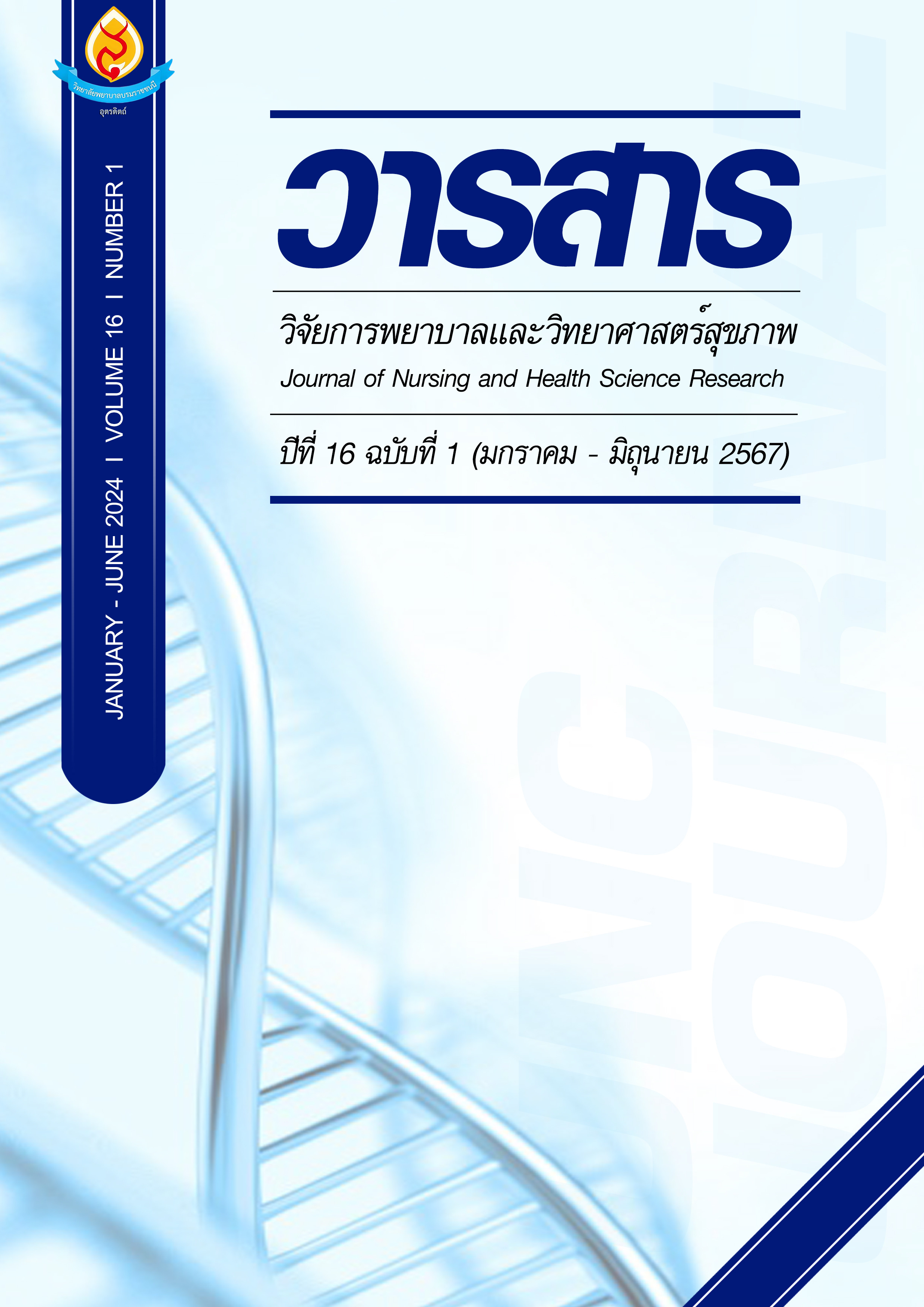ผลของการใช้แนวปฏิบัติการพยาบาลทารกเกิดก่อนกำหนดที่ได้รับการช่วยหายใจ แบบไม่รุกรานต่อการเกิดภาวะแทรกซ้อนจากการช่วยหายใจแบบไม่รุกราน
Main Article Content
บทคัดย่อ
การศึกษานี้เป็นการวิจัยกึ่งทดลองแบบสองกลุ่มวัดผลหลังการทดลอง เพื่อศึกษาผลของการใช้แนวปฏิบัติทางการพยาบาลทารกเกิดก่อนกำหนดที่ได้รับการช่วยหายใจแบบไม่รุกราน คัดเลือกกลุ่มตัวอย่างแบบเจาะจงตามคุณสมบัติที่กำหนดจำนวน 60 ราย แบ่งเป็นกลุ่มควบคุม 30 ราย ได้รับการพยาบาลตามมาตรฐานปกติกลุ่มทดลอง 30 ราย ได้รับการพยาบาลตามแนวปฏิบัติการพยาบาลทารกแรกเกิดที่ได้รับการช่วยหายใจแบบไม่รุกราน เครื่องมือที่ใช้ในการวิจัยประกอบด้วย แนวปฏิบัติการพยาบาลทารกเกิดก่อนกำหนดที่ได้รับการช่วยหายใจแบบไม่รุกราน แบบบันทึกข้อมูลทั่วไป และแบบประเมินแผลกดทับรอบจมูก เยื่อบุจมูกบวม และภาวะท้องอืด วิเคราะห์ข้อมูลด้วยสถิติพรรณนา เปรียบเทียบความแตกต่างของข้อมูลทั่วไประหว่างกลุ่มควบคุมและกลุ่มทดลองด้วยสถิติ Mann-Whitney U-test และสถิติ independent t-test เปรียบเทียบการเกิดภาวะแทรกซ้อนของทั้งสองกลุ่มด้วยสถิติ chi-square
ผลการศึกษาพบว่าข้อมูลทั่วไปของทั้งสองกลุ่มไม่แตกต่างกัน (p>.05) การเกิดแผลกดทับรอบจมูก ภาวะเยื่อบุจมูกบวมและภาวะท้องอืดของกลุ่มทดลองน้อยกว่ากลุ่มควบคุมอย่างมีนัยสำคัญทางสถิติ (p<.05)
ผลการวิจัยนี้แสดงให้เห็นว่า การใช้แนวปฏิบัติการพยาบาลทารกเกิดก่อนกำหนดที่ได้รับการช่วยหายใจแบบไม่รุกรานสามารถช่วยลดการเกิดภาวะแทรกซ้อนจากการได้รับการช่วยหายใจแบบไม่รุกรานของทารกเกิดก่อนกำหนดได้
Article Details

อนุญาตภายใต้เงื่อนไข Creative Commons Attribution-NonCommercial-NoDerivatives 4.0 International License.
บทความหรือข้อคิดเห็นใดใดที่ปรากฏในวารสารวิจัยการพยาบาลและวิทยาศาสตร์สุขภาพ เป็นวรรณกรรมของผู้เขียน ซึ่งบรรณาธิการหรือสมาคมศิษย์เก่า ไม่จำเป็นต้องเห็นด้วย และบทความที่ได้รับการตีพิมพ์เผยแพร่ถือเป็นลิขสิทธิ์ของวารสารวิจัยการพยาบาลและวิทยาศาสตร์สุขภาพ
เอกสารอ้างอิง
Bashir, T., Murki, S., Kiran, S., Reddy, V. K. & Oleti, T. P. (2019). 'Nasal mask’ in comparison with ‘nasal prongs’ or ‘rotation of nasal mask with nasal prongs’ reduce the incidence of nasal injury in preterm neonates supported on nasal continuous positive airway pressure (nCPAP): A randomized controlled trial. PLoS One, 14(1), e0211476.
Behnke, J., Lemyre, B., Czernik, C., Zimmer, K. P., Ehrhardt, H. & Waitz, M. (2019). Non-invasive ventilation in neonatology. Deutsches Ärzteblatt International, 116(11), 177-183. doi.org/10.3238/arztebl.2019.0177
Boel, L., Hixson, T., Brown, L., Sage, J., Kotecha, S. & Chakraborty, M. (2022). Non-invasive respiratory support in preterm infants. Paediatric Respiratory Reviews, 43, 53-59. doi.org/https://doi.org/10.1016/j.prrv.2022.04.002
Brouwers, M. C. et al. (2010). AGREE II: advancing guideline development, reporting and evaluation in health care. Canadian Medical Association journal, 182(18), E839-E842.
Chinthanawongsa, P., Pookboonmee, R. & Orathai, P. (2016). The effect of clinical nursing practice guidelines to prevent nasal skin injury on nasal skin injury of premature infants with nasal continuous positive airway pressure. Ramathibodi Nursing Journal, 22(1), 35-48. (in Thai).
Elsobkey, F. A. & Amer, S. A. M. (2018). Effect of educational guidelines program about nursing care of neonates receiving continues positive airway pressure. IOSR Journal of Nursing and Health Science, 7(3), 16-26.
Guay, J. M., Carvi, D., Raines, D. A. & Luce, W. A. (2018). Care of the neonate on nasal continuous positive airway pressure: a bedside guide. Neonatal Network, 37(1), 24-32.
Imbulana, D. I., Manley, B. J., Dawson, J. A., Davis, P. G. & Owen, L. S. (2018). Nasal injury in preterm infants receiving non-invasive respiratory support: a systematic review. Archives of Disease in Childhood - Fetal and Neonatal Edition, 103(1), F29-F35. doi.org/10.1136/archdischild-2017-313418
Jirapaet, V. (2020). Nursing care during mechanicak ventilation In S. Punnahitanon (Ed.), Important Issues in Neonatology (Vol. 1, pp. 107-116). Thai Neonatal Society .
Mahmoud, R. A., Schmalisch, G., Oswal, A. & Christoph Roehr, C. (2022). Non-invasive ventilatory support in neonates: An evidence-based update. Paediatric Respiratory Reviews, 44, 11-18. doi.org/10.1016/j.prrv.2022.09.001
Medical and health data system Ministry of Public Health. (2023). Percentage of Thai women giving birth prematurely in the fiscal year. Retrieved (2023, November 2). from
https://hdcservice.moph.go.th/hdc/reports/report.php?source=pformated/%20format 1.php&cat_id=1ed90bc32310b503b7ca9b32af425ae5&id=ecdbfc8b4725386c34623ce99f0f4b8d (in Thai).
Nasef, N., Rashed, H. M. E. & Aly, H. (2020). Practical aspects on the use of non-invasive respiratory support in preterm infants. International Journal of Pediatrics and Adolescent Medicine, 7(1), 21-27. doi.org/https://doi.org/10.1016/j.ijpam.2020.02.005
Ohuma, E. O. et al. (2023). National, regional, and global estimates of preterm birth in 2020, with trends from 2010: a systematic analysis. The Lancet, 402(10409), 1261-1271.
doi.org/10.1016/S0140-6736(23)00878-4
Polit, D. & Beck, C. (2020). Essentials of nursing research: Appraising evidence for nursing practice. Lippincott Williams & Wilkins.
Ramaswamy, V. V., Devi, R. & Kumar, G. (2023). Non-invasive ventilation in neonates: a review of current literature. Front Pediatr, 11, 1248836. doi.org/10.3389/fped.2023.1248836
Ribeiro, D. d. F. C., Barros, F. S., Fernandes, B. L., Nakato, A. M. & Nohama, P. (2021). Incidence and Severity of Nasal Injuries in Preterm Infants Associated to Non-Invasive Ventilation Using Short Binasal Prong. Global Pediatric Health, 8, 2333794X211010459. doi.org/10.1177/2333794X211010459
Said, K. M., Mohamed, R. A. & Draz, S. F. (2019). Effect of nursing protocol regarding nasal skin breakdown for preterm infants receiving continuous positive airway pressure. Evidence- Based Nursing Research, 1(3), 189-204.
Sammour, I. & Karnati, S. (2020). Non-invasive respiratory support of the premature neonate: from physics to bench to practice. Frontiers in pediatrics, 8, 214.
Shi, Y., Muniraman, H., Biniwale, M. & Ramanathan, R. (2020). A review on non-invasive respiratory support for management of respiratory distress in extremely preterm infants. Frontiers in pediatrics, 8, 270.
Uttaradit Hospital. (2023). Report on the use of mechanical ventilation in premature infants. (in Thai).
Wise, J. (2023). UN warns of preterm birth rates flatlining in every region. The British Medical Journal, 381, 1054. doi.org/10.1136/bmj.p1054


